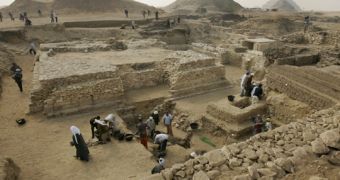A 4,300-year old pyramid has been discovered at Saqqara, the ancient Egyptian necropolis and burial place of the pharaohs. The monument was lying buried under the desert sands and was effectively discovered two years ago. But the announcement comes so late because the archaeologists wanted to be sure that it was indeed a pyramid. The prevalent idea is that it may have belonged to Queen Sesheshet, the mother of King Teti (the founder of the 6th Egyptian Dynasty who ruled between 2323 to 2291 BC), according to the Egyptian chief of antiquities, Zahi Hawass.
"The only queen whose pyramid is missing is Sesheshet, which is why I am sure it belonged to her. This will enrich our knowledge about the Old Kingdom," shared Hawass, quoted by Reuters. Although two more tombs belonging to Teti's other wives had been previously found, the one dedicated to Sesheshet was still missing.
The monument appears to have been beheaded by time and erosion, and in its current state, it measures 5 meters (16 feet) in height, but Hawass indicates that it originally stood 14 meters (46 feet) tall, while its sides spread for about 22 meters (72 feet) in length. According to Hawass, it was once covered with white limestone carried from the neighboring city of Tura. This is the 118th pyramid ever discovered in Egypt, probably the most complete of the subsidiary tombs (those not belonging to pharaohs) and it stands very close to the oldest one ever found.
For the moment, the experts did not open the inner burial chambers, but they will do so in about two weeks, although they don't expect to find much left. Most likely, tomb raiders and time have done their jobs pretty thoroughly since then. Also, the discovered artifacts (a statue of the god Anubis made of wood and burial items from a later period) hint that the Romans also used the site for funeral purposes.

 14 DAY TRIAL //
14 DAY TRIAL //